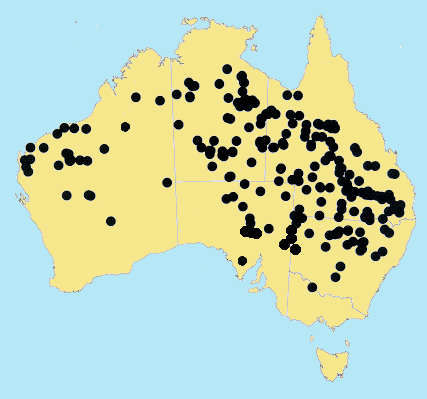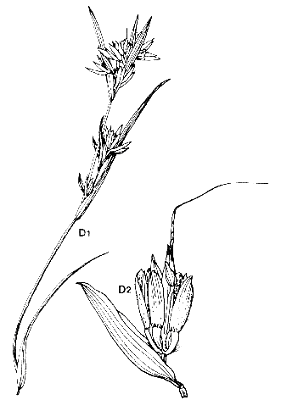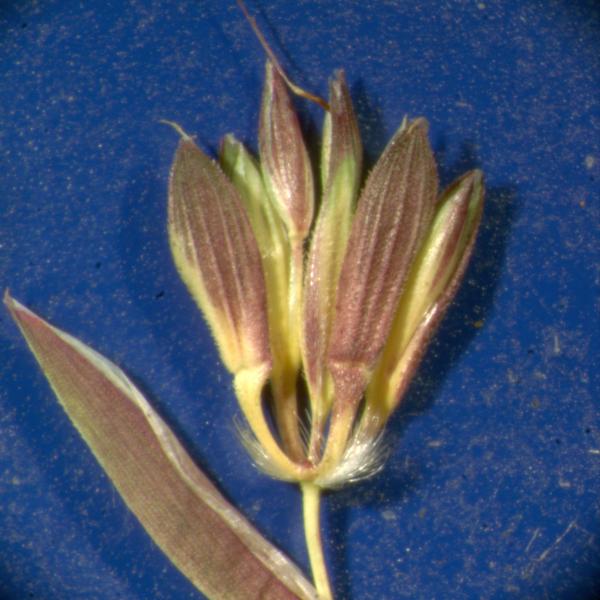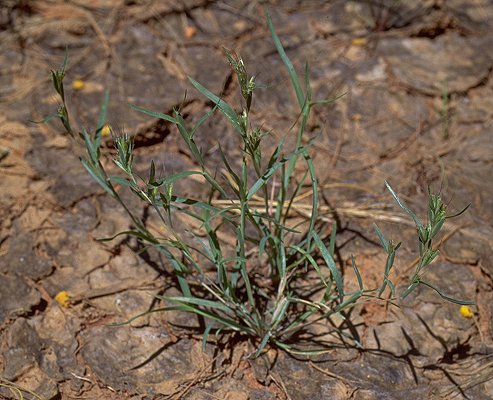Iseilema membranaceum (Lindl.) Domin. Biblioth.
Bot. 85: 280 (1915).
Classification. (GPWG 2001) : Subfamily
Panicoideae. Andropogoneae.
Basionym and/or
Replacement Name: Anthistiria
membranacea Lindl., Trop. Austr. 88 (1848).
Type of Basionym or
Protologue Information: Australia,
Narran R.: Coll?.
Key references
(books and floras): [1878] G.Bentham, Flora Australiensis 7 (543 as Anthistiria
membranacea), [1981] M.Lazarides in J.Jessop (ed)., Flora of Central
Australia (492), [2002] D.Sharp & B.K.Simon, AusGrass, Grasses of
Australia, [2006] J.Jessop, G.R.M.Dashorst, F.M.James, Grasses of South
Australia (526), [2008] S.W.L.Jacobs, R.D.B.Walley & D.J.B.Wheeler, Grasses
of New South Wales (286).
Illustrations:
[2006] J.Jessop, G.R.M.Dashorst, F.M.James, Grasses of South Australia (527, fig. 449), [2008] S.W.L.Jacobs,
R.D.B.Whalley & D.J.B.Wheeler, Grasses of New South Wales, 4th edn
(286).
Habit. Annual.
Culms erect or geniculately ascending, 5–40(–90) cm tall. Ligule a fringed
membrane, a ciliolate membrane, 1 mm long. Leaf-blades flat or conduplicate,
2–20 cm long, 2–5 mm wide.
Inflorescence.
Inflorescence compound, composed of rames.
Spikelets.
Spikelets sessile, 1 in the cluster. Companion spikelets pedicelled, 2 in the
cluster. Basal sterile spikelets well-developed, 4 in number. Companion
spikelets developed, containing empty lemmas or male, 2–3.5 mm long. Companion
spikelet glumes muticous. Fertile spikelets 2-flowered, the lower floret barren
(rarely male), the upper fertile, comprising 1 basal sterile florets,
comprising 1 fertile floret(s), without rachilla extension, lanceolate,
dorsally compressed, 5–6 mm long.
Glumes. Glumes
dissimilar, firmer than fertile lemma. Lower glume lanceolate, coriaceous,
without keels, 8 -nerved. Upper glume lanceolate, coriaceous, 3 -nerved. Florets.
Basal sterile florets 1, barren, without significant palea. Lemma of lower
sterile floret hyaline, 0 -nerved. Fertile florets female.
Fertile lemma 2.5–3.5
mm long, 1 -nerved. Lemma apex entire, muticous or awned, 1 -awned. Median
(principal) awn 0–15 mm long overall, without a column or with a twisted
column. Palea absent. Grain 2–2.2 mm long.
Continental
Distribution: Australasia.
Australian
Distribution: Western Australia, Northern Territory, South Australia,
Queensland, New South Wales.
Western Australia: Canning,
Carnarvon. Northern Territory: Darwin & Gulf, Victoria River,
Barkly Tableland, Central Australia North, Central
Australia South. South Australia:
Lake Eyre, Gairdner-Torrens Basin, Flinders
Ranges, Eastern, Eyre
Peninsula. Queensland:
Burke, Darling Downs, Gregory North,
Leichhardt, Maranoa, Mitchell, Moreton, Port Curtis, South Kennedy, Warrego,
Gregory South. New South Wales: North-Western Slopes, Central-Western
Slopes, North-Western Plains, South-Western Plains, North Far Western Plains.
Notes.
Growing in clay and stoney soils in all mainland states except Vic. Flowers
mainly Dec.--July.






